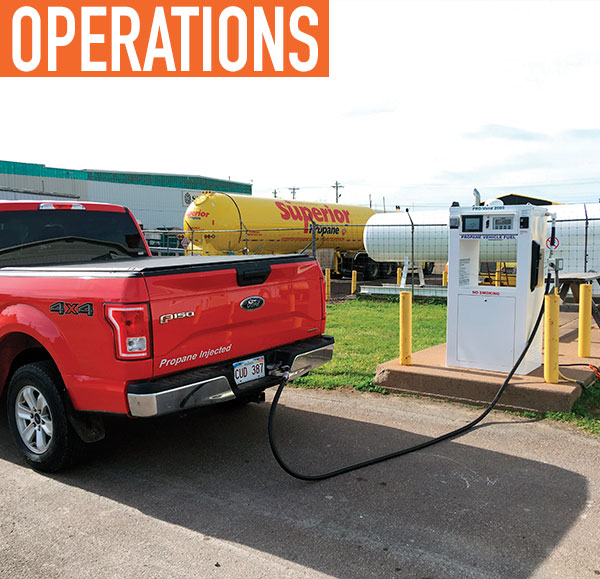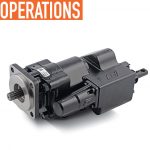With tens of thousands of propane-powered commercial trucks in North America, chances are your fleet drivers pass a few on the road. What isn’t obvious is how those propane trucks produce much less harmful emissions than their traditionally fueled counterparts. And new propane engine and fuel technology take those numbers even lower.
Even though today’s diesel vehicles are cleaner than year’s past, there’s still reason to entertain an alternative fuel. Diesel trucks are cleaner only through complexity, like expensive equipment and high-maintenance systems. Engines fueled by propane autogas require less oil by volume than diesel without additional diesel emission fluids or extra valve adjustments. This cuts down on servicing the pricey diesel after-treatment items, such as maintenance parts and fluids, because propane’s chemical properties allow it to power an engine while reducing the emissions released into the atmosphere.
AUTOGAS STATS
Heavier-duty vehicles fueled by propane autogas emit 80% fewer smog-producing hydrocarbons and virtually eliminate particulate matter when compared to conventional diesel-powered vehicles. When compared to gasoline, vehicles fueled by propane autogas produce up to 25% fewer greenhouse gases, 20% less nitrogen oxide, up to 60% less carbon monoxide, and 40% fewer smog-producing hydrocarbons while fueling.
Propane is a clean-burning, low-carbon fuel with three parts carbon and eight parts hydrogen. And it’s a nontoxic fuel that poses no harm to groundwater or soil. Propane autogas trucks reduce drivers’ exposure to the harmful particulate matter in diesel exhaust, which is known to aggravate asthma and is identified as a carcinogen by the World Health Organization.
To encourage manufacturers to go even greener, the California Air Resources Board (CARB) established optional low-nitrogen oxide standards below the EPA’s 0.2 grams per brake horsepower hour (g/bhp-hr) standard. Nitrogen oxides, known as NOx, are highly reactive gases composed of nitrogen and oxygen. Approximately 55% of man-made NOx emissions come from motor vehicles.
Manufacturers may choose to certify engines to the California Optional Low NOx Standards of 0.10, 0.05, or 0.02 g/bhp-hr. In 2018, one clean fuel technology company, ROUSH CleanTech, received CARB certification for its 0.02g ultra-low NOx 6.8-L V10 3V propane engines for Class 4 to 7 vehicles. When fueled by traditional propane autogas, this engine is 90% cleaner than national emissions standards.

100% RENEWABLE
In addition to traditional propane, these engines can be powered by “renewable propane”—an up-and-coming transportation fuel. It is a non-fossil fuel that is produced from 100% renewable raw materials such as waste, residue, and sustainably produced vegetable oils. There is growing interest in renewable propane (also known as biopropane) due to its near-zero emission levels, reduced greenhouse gases, and ability to help meet growing demand for cleaner products. It can be used as a “drop-in” replacement fuel because it is chemically nearly identical to conventional propane.
Many companies around the globe are developing renewable propane production technology with some in commercial volume as a byproduct of renewable diesel plants. It is available in the United States today, and the pricing is on par with traditional propane. As the demand grows in places like California, the producers of renewable propane will develop the infrastructure to distribute this fuel efficiently. The latest ultra-low NOx propane engine technology coupled with renewable propane is a cost-effective method to reach near-zero emissions.
Readily available, cost-effective propane autogas vehicles coupled with renewable propane nearly eliminate emissions and help reduce your fleet’s carbon footprint for a sustainable future and greener fleet.
REFUELING PROPANE AUTOGAS WORK TRUCKS
By Crystelle Markley, Superior Energy Systems
CENTRALIZED, ON-SITE REFUELING
When space allows, many truck fleets opt to install an on-site refueling station. With this option, a local propane supplier delivers fuel directly to the business. Oftentimes, fleets work with a fuel supplier to negotiate a contract to buy fuel in bulk to save money on fuel costs. On-site refueling includes a large-capacity fuel storage tank(s) equipped with a pump, meter, and one or more refueling dispensers. As a fleet expands, the infrastructure can easily accommodate a growing number of vehicles with no electrical or site upgrades.
ON-SITE REFUELING CONFIGURATIONS
A large fleet with 50 vehicles or more generally opts for an advanced private station, which includes a high-capacity tank, optional canopy, and multiple fuel dispensers. The infrastructure is owned by either the fleet or the fuel supplier. If a fleet chooses not to own the infrastructure, it is generally only responsible for site preparation costs involved with the installation. A fleet with fewer than 50 vehicles generally chooses to install a standard private station that would include a smaller, 1,000- to 3,000-gallon tank and a single autogas fuel dispenser. Again, the infrastructure is owned by either the fleet or the fuel supplier.
TEMPORARY REFUELING
If a fleet is in the process of procuring permanent refueling infrastructure, a temporary refueling setup can help during the transition period. This setup includes a dispenser, pump, and fuel storage tank mounted on a trailer and owned by the propane supplier. It can be used for any necessary amount of time.
MOBILE REFUELING
For fleets just getting started with propane autogas but not ready to purchase their own infrastructure, mobile refueling can be a practical, impermanent solution. With mobile refueling, a propane supplier comes to a designated fleet location and refuels vehicles with a propane delivery truck. This can be a more costly solution dependent on several factors.
PUBLIC REFUELING
Fleets with limited space or those requiring more fueling locations along their routes can take advantage of a network of public and private refueling stations with no infrastructure investment. These stations are accessible to fleets 24/7 through a card lock system. Go to www.afdc.energy.gov/stations to search for propane autogas stations in your area, along with open hours (available to refuel without a key card) as well as payment options. If a network is not available in a fleet’s area, a propane supplier may create one depending on the fleet size and other parameters. Multiple fleets in one geographic area can also team up to provide adequate gallon requirements to request the installation of a refueling network.
TIPS FOR REFUELING SUCCESS
1. Know Your Manufacturer
- Filling vehicles requires a differential pump pressure of 120 psid to create optimal filling rate of 10-12 gallons per minute.
- Verify that you install technologically compatible refueling dispensers.
2. Approved Equipment
- Autogas dispensers must meet NFPA 30A and NFPA 58 requirements and be listed by an accredited agency such as UL or CSA.
- It is important to make sure you purchase safe, approved equipment.
- Verify Authority Having Jurisdiction (AHJ) regulations in your area.
3. Reach Out
- Contact a propane retailer in your area:
www.retailers.propane.com. - Many offer to include the cost of installing a propane autogas station at your location in exchange for a fuel contract.
4. Education and Safety
- Be certain your propane supplier is trained to maintain your autogas refueling equipment.
- Make sure all employees are trained in the safe practices and handling of propane.
- More resources are available at www.propanecouncil.org.
ABOUT THE AUTHOR
Todd Mouw is president of ROUSH CleanTech, an industry leader of alternative fuel vehicle technology. Mouw has served as president of the NTEA Green Truck Association. Reach him at todd.mouw@roush.com or 800.59.ROUSH. Find out more, visit www.roushcleantech.com.
MODERN WORKTRUCK SOLUTIONS:
OCTOBER 2019 ISSUE
Did you enjoy this article?
Subscribe to the FREE Digital Edition of Modern WorkTruck Solutions magazine.





